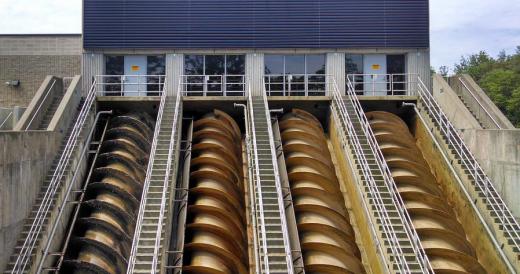Hydraulic pumps are mechanical devices designed to move fluids with sufficient pressure to impart energy in the fluid body. This is a rather technical way of saying that a hydraulic pump pumps a fluid, typically a low viscosity oil, hard enough that it may be used to perform work. There are several different types of hydraulic pumps in general use, most of which feature close-tolerance rotary mechanisms that operate at comparatively low speeds. These include gear pumps, screw pumps, and fixed-displacement vane pumps. Gerotor and radial, or axial, piston pumps are also frequently-used types of hydraulic pumps.
Hydraulic systems are work-producing entities that use compressed fluid to perform that work. The fluid used is usually a fairly thin oil of a special grade that is pumped into the system to produce the working pressure by various types of hydraulic pumps. These pumps generally have rotary mechanisms with small tolerances between the moving parts and the casings. In comparison to other fluid pumps, most types of hydraulic pumps also feature fairly low rotational speeds.

One of the more common types of hydraulic pumps are gear pumps. These devices consist of a pair of meshed gears that rotate inside a close-fitting casing. The oil is introduced on one side of the casing and is carried around its outer area between the gear teeth and out of the discharge point on the opposite side. Some gear pumps have one eccentric external tooth gear that rotates around the teeth of an internal gear, and functions in much the same way as the previous example. Gear pumps are generally efficient and reliable, although older models may be very noisy.
Rotary vane pumps are another common hydraulic pump type and feature a set of constantly-adjustable vanes mounted on an eccentric hub within a closed housing. As the hub moves around the casing, the vanes constantly adjust to keep their tips in contact with the casing's inner surface. Oil is introduced into the casing and is carried around it by the vanes to the discharge point where it is forced out. Rotary vane types of hydraulic pumps are usually more efficient than gear pump variants.
A third commonly-used hydraulic pump is the screw pump. These pumps feature a pair of meshing spiral gears located within a closed cylinder. This arrangement works in the same way as the Archimedes' screw, with oil being introduced at one end of the cylinder where it is forced along its length between the teeth of the meshing gears and the cylinder walls. Other types of hydraulic pumps in general use include radial piston pumps, axial piston pumps, and gerotor pumps.
